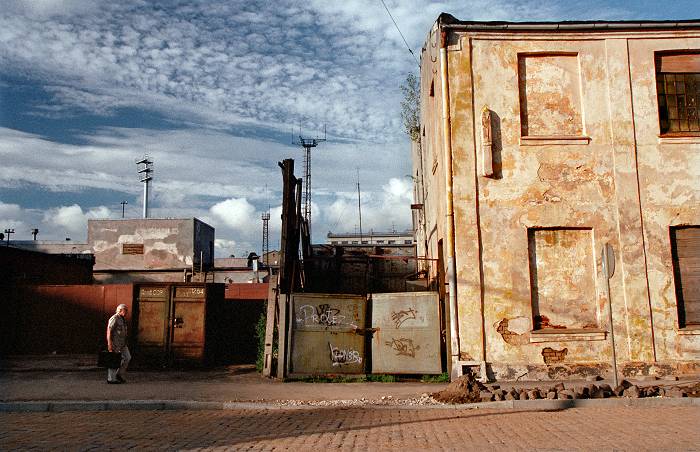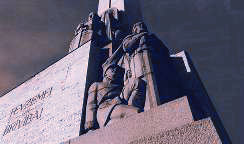|
Sveiki, all!
I turned out we took a longer than
intended holiday hiatus as we kept more than busy! (Peters' mother came home
from Latvia, Silvija's sister came to visit over Christmas....) A Happy New
Millenium (this time, the real one) to one and all!
Things have been
quiet on the news front the last couple of weeks. Most disturbing, however, are
recent U.S. allegations of a Russian nuclear presence in the Baltics (which the
Russians have denied). Most fantastical is that the Ark of the Holy Covenant
and Holy Grail may be hidden on a Baltic Island!
In the news:
- Templar Treasures Hidden on Baltic Sea Island?
- Latvian foreign minister to visit Russia
- U.S.: Russia Moved Weapons
This week's picture was taken along a Riga side-street last
summer.
As always, mailer or not, Lat Chat spontaneously appears every
Sunday on AOL starting around 9:00/9:30pm Eastern time, lasting until
11:00/11:30pm. AOL'ers can follow this link:
Town Square - Latvian chat. And
thanks to you participating on the Latvian message board as well:
Click here: LATVIA (both on AOL
only).
Ar visu labu,
![]()
![]()
|
Copyright 2001 Reuters Ltd.
By Peter Starck
COPENHAGEN (Reuters) — The Holy Grail and the Ark of the Covenant may have been hidden by a secretive religious order of crusaders, the Knights Templar, on the Baltic Sea island of Bornholm some 830 years ago, according to a new book.
The whereabouts of the grail and the ark — legendary religious relics of immeasurable value to Christian and Jewish believers — have intrigued historians and archaeologists for centuries and films about quests to locate them, notably the "Indiana Jones" series, have thrilled movie audiences worldwide.
No one knows exactly what the relics actually are but the ark is believed a box-type container that held the stone tablets inscribed with the 10 commandments which Moses received from God on Mount Sinai.
Legends differ about the Holy Grail but it is most widely thought to be the chalice which Jesus and his apostles drank from at last supper before he was crucified.
Some scholars speculate that treasures amassed by the Knights Templar ended up in Rosslyn chapel in Scotland. Others have hinted at locations in Ethiopia, Spain and Canada.
In a 194-page book "The Templars' Secret Island," Denmark's Erling Haagensen and Henry Lincoln of Britain say medieval round churches were built at sites on Bornholm based on the sacred geometry used by the Knights Templar elsewhere in Europe, most famously at Rennes-le-Chateau in southern France.
The book, studded with graphs, plots the churches' geometric layout with mathematical precision and the authors suggest the design may be a map to hidden treasures.
The Danish archbishop Eskil visited Knights Templar Grand Master Bertrand de Blanchefort in France in 1162, nine years after the death of his predecessor Bernard of Clairvaux.
The historically recorded purpose of Eskil's visit — coming at a time when the Knights Templar may have feared becoming vulnerable because of the influential Bernard's demise — was to prepare a crusade against pagans inhabiting the Baltic Sea's northeastern coast in what is today Estonia and Latvia.
The book suggests that Knights Templar who joined the Baltic crusade built Bornholm's churches and may have taken the opportunity to stash some treasures there.
"The need for a secure hiding place would have been paramount...It would make sense to conceal whatever may have been the Order's treasures in more than one place.
"Better still to provide a hiding place which was remote and had no apparent connection with the Order. Bertrand's involvement in the planning for the Baltic Mission would have offered him the perfect opportunity. Bornholm...now becomes a trump card," says the book.
"It was small and easily controlled and protected. Above all, it was remote, unknown, unlikely to be disturbed, not big enough or rich enough to attract an errant warrior intent on carving out a kingdom," it continues.
UNIQUE CHURCHES LASTING HERITAGE
The European Templar Heritage Research Network (ETHRN), a non-profit making association of scholars not affiliated to any religious or political group, says it has been historically documented that the order of the Poor Knights of Christ and the Temple of Solomon — the full name of the Knights Templar — was founded by aristocrats from the French region of Burgundy early in the 12th century.
The order's classic round churches founded on octagonal geometry, supposedly based on the design of the Church of the Holy Sepulchre in Jerusalem, are a lasting heritage of the Knights Templar era, the ETHRN says.
Historical records and 20th century archaeological digs indicate that a group of Knights Templar were searching for something under Jerusalem's Temple Mount between 1118 and 1127.
Haagensen and Lincoln say that on returning to France in 1127 the crusaders reported to Bernard of Clairvaux that their "mission" had been accomplished.
A carving on a pillar at the cathedral in Chartres, France, suggests the mission had been to find the Ark of the Covenant.
Legends say Mary Magdalen, to this day the village saint of Rennes-le-Chateau, and Joseph of Arimathea, who according to the Bible buried Jesus, took the Holy Grail to France.
Evidence of the belief in this tale is found in historical records about the Nazis searching for the Holy Grail at Rennes-le-Chateau during World War Two.
Backing up the theory that Knights Templar treasures may have been hidden on Bornholm, the book says ancestors of the noblemen who founded the order lived on this rocky 587 square km (226.7 square miles) island, now part of Denmark and home to some 45,000 people.
BURGUNDIANS CAME FROM BORNHOLM
The authors point to a find of nearly 3,000 tiny, intricately carved golden figures unearthed in a 1985-86 excavation of a Bornholm field as lending credibility to their claim of a Bornholm connection.
The golden figures have been dated to AD 400-600 when the Merovingians — a clan of Frankish kings who claimed to be, like Jesus, of the house and lineage of the Bible's King David — were at the height of their power. Descendants of the Merovingians later settled in Burgundy.
The book also quotes a AD 417 work by Spanish historian Orosius, which says the Burgundians came from Bornholm.
The Knights Templar viewed the Holy Grail and the Ark of the Covenant as their rightful possessions because of their bloodline to the House of David, scholars say.
The equilateral six-sided shape which forms the star of David is part of the geometric design formed by Bornholm's medieval churches, the book by Haagensen and Lincoln shows.
"It is undeniable that those who planned and built the churches of Bornholm knew exactly what they were doing and why they did it," the authors say, adding the design "indicated a sure hiding place."
An excavation in 1995 to install heating ducts under the floor of Oesterlars church, the biggest of Bornholm's round churches, found "unusual and unexpected stone features...which might be explained by the presence of an undiscovered crypt," the book says, quoting the official renovation report.
Olsker, another church in the geometric pattern, also features a "curious indication of a possible underground structure beneath a staircase," the authors say.
"Neither of these subterranean anomalies has, thus far, been investigated."
Copyright 2001 ITAR-TASS
MOSCOW, December 25 (Itar-Tass) — Latvian Foreign Minister Indulis Berzins will make a working visit to Russia on January 18-19, 2001, well-informed sources told Itar-Tass on Monday.
The Latvian minister will arrive in Moscow at the invitation of the Russian government.
During the visit, Berzins is expected to hold talks with his Russian counterpart Igor Ivanov to discuss bilateral relations, in particular the state of Russian ethnics in Latvia.
Copyright 2001 The Associated Press
By ROBERT BURNS, AP Military Writer
WASHINGTON (AP) — U.S. intelligence agencies have concluded that Russia moved short-range nuclear weapons onto one of its military bases in the Baltics, senior Clinton administration officials said Wednesday.
The move would be in conflict with Moscow's stated policy of keeping the Baltics free of nuclear weapons, although it would not appear to violate any legally binding arms control agreement, U.S. officials said.
The Russian Navy, whose Baltic Fleet is headquartered at the base in Kaliningrad, denied the report, according to the Russian news agency Tass. It quoted Anatoly Lobsky, assistant to the fleet commander, as saying Russia is unconditionally fulfilling its pledge to keep the Baltics a nuclear-free zone.
Two senior U.S. officials with access to intelligence reports on the subject said there have been recent indications of movement of Russian nuclear weapons to Kaliningrad. They said some weapons may have been there a year or longer. Both officials agreed to discuss the matter only on condition they not be identified.
The officials would not discuss numbers or specific types of Russian weapons in Kaliningrad.
Kaliningrad is a Baltic Sea port located between Poland and Lithuania on a sliver of Russian territory not connected to the main part of Russia.
The movement of Russian nuclear weapons, first reported in Wednesday's Washington Times, may reflect Moscow's response to NATO's eastern expansion in 1999 when Poland, Hungary and the Czech Republic joined the alliance.
The Baltic states of Lithuania, Latvia and Estonia — which were part of the Soviet Union before its collapse in 1991 — want to be the next new members. Russia has said it could not tolerate NATO so close to its border.
Russia views NATO expansion as a potential military threat and has said it would undermine arms control.
State Department spokesman Richard Boucher said he could not comment on specifics of Russian nuclear weapons in Kaliningrad but expected the topic to be raised with Moscow.
"It's an issue that we want to take up, that we want to discuss with them," he said. "It's something that we follow carefully, and that's about as far as I go."
One administration official said the matter had already been discussed within NATO councils.
Pentagon spokesman Kenneth Bacon said he could not comment on the matter because it involves intelligence issues.
Boucher said Russian leaders had made unilateral pledges in the past to keep nuclear weapons out of the Baltics. Those promises stem from the period immediately after the collapse of the Soviet Union, when both Washington and Moscow took unilateral steps to reduce the number of tactical nuclear weapons outside their borders. That was partly a response to the end of the Cold War and partly a desire by both governments to reduce the chances of unauthorized transfers of nuclear weapons materials.
Moscow has long argued for the removal of all U.S. tactical, or short-range, nuclear weapons from Europe. The United States withdrew many missiles and other nuclear weapons from Europe in the 1980s and 1990s but maintains some nuclear bombs for aircraft based there.
Some administration officials believe Russia may have moved weapons to Kaliningrad in order to raise diplomatic pressure on the United States to withdraw its remaining nuclear weapons from Europe.
The Baltic states Wednesday expressed concern but said they didn't know enough to fully assess the potential threat.
"We don't know whether it's true or not," the office of Estonian Foreign Minister Toomas Ilves quoted the minister as saying. "But if it is true, it is regretful, because it decreases the stability of the region."
Lithuanian Defense Minister Linas Linkevicius said in an interview, "This sounds alarming, but I see no reason Russia should try to escalate the situation in Baltic region."
Liiga Bergmane, spokeswoman at Latvia's Foreign Ministry, said Latvia would seek independent confirmation of the reports.
"We don't see any reason why Russia should want to change its policy of keeping these kinds of weapons out of the Baltic region," she said. "Russia pledged not to increase nuclear arms here and we can't imagine why it would reconsider."
|
The Latvian sky and warm rays of the summer evening sun low on the horizon imbue any scene with wonderful colors. Even the most rundown building can look almost magical.

 Gallery
Gallery
